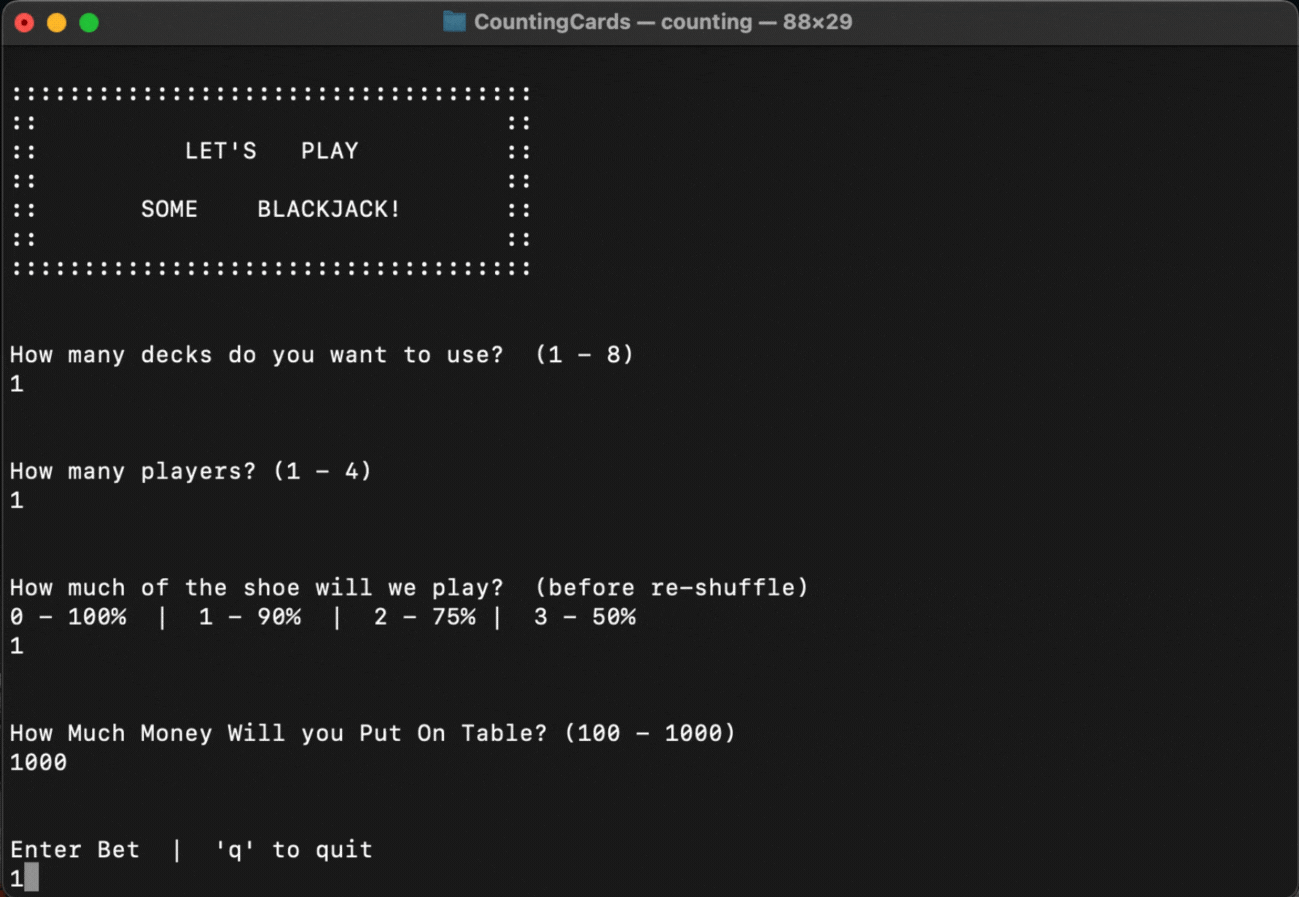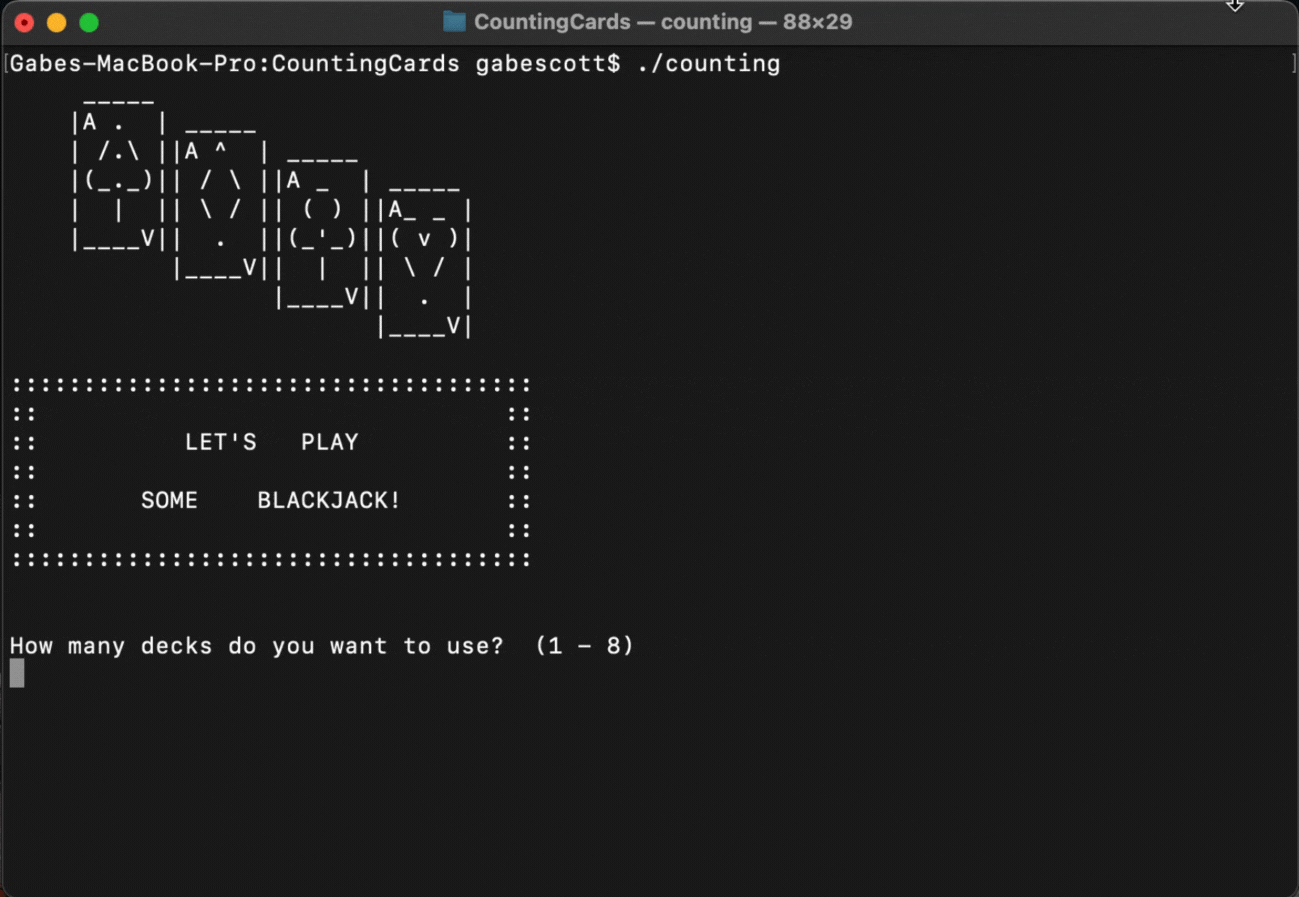View source code files in directory ./CountingCards/ or click here
Who doesn't love a good game of blackjack? CountingCards helps the player learn blackjack gameplay and basic strategy, provides a fun way to practice keeping the count of the deck, offers advice on adjusting your bet and adjusting strategy based on the count of the deck.
CountingCards is a fun and educational way to help the you bring your best game to the casino or to a blackjack game among friends. It will help you win money at blackjack, or at the very least, limit your losses
For Unix architecture (Mac or Linux):
- Download folder from this repository containing source files: ./CountingCards/
- In a terminal, navigate to that source code folder
- Run Makefile with command:
makeORmake all - Run resultant executable file named "counting" with command:
./counting - optional: After compilation, execute command
make cleanto remove object files and the compiled executable file called "counting"
Note:
- If you have limited/no developer experince, and haven't installed command line tools before, open INSTALLATION.md and follow the more detailed instructions to compile the code
- Choose how many decks of cards you want in the dealer's shoe
- Choose how deep to set the cut card - This simluates a real world blackjack game and should affect one's counting and betting strategy
- Play 100% of shoe (This isn't done in real life games)
- Play 90% of shoe
- Play 75% of shoe
- Play 50% of shoe
- Choose total number of players (e.g. choosing 4 would result in 3 computer players and him/herself)
- Add funds to Bankroll, up to MAX_RELOAD, at one time
- In order to keep it fun, MAX_RELOAD also functions as the table's maximum bet
- Check your own count of the shoe against the true count, kept by CountingCards
- Track net win/loss over entire session
- Computer players all play according to common basic strategy for their hand vs the dealer's shown card
- Net session results are displayed at end of game, when the quit option is requested
- Testing Mode (hidden feature):
- If the user inputs the number of players to be 9, they can choose the hand that is dealt to them
- User can then choose the card they receive from hitting or doubling.
- Since these cards are not dealt out of the shoe, they do not affect the count
- The game prompts the user to enter one to four players, so one would have to know about this mode beforehand. There is no prompt on-screen that tells the player about this
In-game Action Menu:
| Character | Action | Description |
|---|---|---|
| 'H' | Hit Hand | Player gets one card added to their hand |
| 'D' | Double Down | Player opts to receive just one card for the rest of the hand, while doubling their current bet |
| 'S' | Split Hand | Player opts to split the hand into two hands and get two more card - one for each hand. Bet is doubled and split between the hands |
| 'P' | Stand Pat | Player opts to not take any more cards, and stand with the hand's current point value |
| 'M' | Strategy Hint | Player requests the basic strategy correct action to take based on their hand's value against dealer's currently shown card |
| 'B' | Reload Bank | Player requests to add funds to their bankroll starting on the next hand - Capped at MAX_RELOAD |
| 'R' | List Rules | Player gets a full list of blackjack rules and terminology |
| 'C' | Get Count | Player requests the current count of the deck - Receives both running count and true count |
| 'Q' | Quit Game | Player chooses to quit, game is exited immediately, with profit/loss statement displayed |
| 'X' | Surrender | (Deprecated) This feature is rare in real games, and would affect this game significantly. I decided against implementing it |
- split and double can be stacked multiple times just like they can in a real game of blackjack
- When adding funds to a player's bankroll, the game tracks add on amounts, and doesn't let the user add more than an amount that would bring player's bankroll back up to MAX_RELOAD during a single hand, even if the option to add on is selected multiple times.
Future Features:
- GUI
- Currently working on a GUI and full mobile game for iOS and Android using React Native, connecting it to the C++ backend. Ideally, the use of React should make it very portable, and able to run on multiple platforms without much modification from one to the next
- Looking into working with open source graphics rendering software called Dear IMGUI
- Ability for player to play multiple hands, with the additional hand acting as another player and reducing the number of players allowed at the table by one
- Analysis of player's betting patterns, and advice on improvement
- Player will be able to get adjusted strategy hints based on count of the deck vs dealer's shown card
- Analysis and tabulation of times when player did not act correctly (according to basic strategy or count adjusted basic strategy)
- option to print these results to file
To view more implementation ideas (both complete and incomplete), see TODO.md
- Blackjack - A two card hand that contains exactly one ace, and one hand counting for 10 points (King, Queen, Jack, or Ten). This pays out at a ratio of 3:2
- Dealer - The person distributing hands to all the players and him/herself.
- Bust, busted - When a hand goes over 21 and is now dead
- Soft Hand - A hand that contains at least one ace still counting for 11 points. Since Aces can count for either 1 or 11 points, this hand has no chance of busting by taking a card
- Hard, hard hand - A hand that does not have any aces counting for 11 in it. It can either contain aces or not
- Shoe - the box that holds the deck(s) that the cards are being distributed from
- Hit, hitting - Taking a card from the shoe
- Double, doubling down - The action of doubling the bet on a hand and taking just one card. This hand's action is now complete
- Split, splitting hand - The action of splitting a pair in a hand into two hands, with each hand then receiving one card. The original bet is doubled and then split between the two hands
- Standing, standing pat - when a player has not busted, and will not be taking any more cards. The action for that hand is complete
- Count - The positive or negative value that is calculated by adding one for high cards, and subtracting one for low cards. A higher count is better for the player, because a deck full of high cards works in the player's favor, due to a higher payout when hitting blackjack
- Players act before the dealer acts
- Players attempt to get the better score between him/herself and the dealer, up to 21, without going over (busting)
- Aces can be worth 11 or 1 points, with the better of the two options applying automatically
- A hand that wins is paid 1:1, unless it is a blackjack, which pays 3:2
- For this particular implementation of Blackjack, the dealer will stand pat on both soft and hard 17s, and any hand with better than 17 points
- For more information about blackjack rules see Bicycle's Blackjack Rules
Generally speaking, the player does not have an edge long-term against the casino in the game of blackjack... However, this can change when the count of the deck becomes high enough, and a player adjusts his bet-sizing accordingly. This is for the simple reason that players get paid 3:2 when hitting blackjack. The more high cards in the deck, the more likely this is to happen. So, assuming a player knows how to play hands correctly, if the player places smaller bets when there are few high cards in the shoe, and larger bets when there are more high cards in the shoe, the player can gain an edge against the casino. CountingCards is a game that aims to help the player learn to do just that.
It is a common misconception that counting cards is against the rules of the game. This is simply not accurate. However, a casino is not required to let you play if they believe you are a good, winning player. A good bet sizing strategy can keep one from drawing too much unwanted attention while playing
The CountinCards shuffle algorithm is based on the modern Fisher-Yates shuffle algorithm, in which each draw of a card from the dealer's shoe is pseudo-random. The algorithm works as follows:
Before each card draw, the random number generator is seeded with the system's current time:
srand((unsigned int)std::time(0));Next, a random number between 0 and _cardsRemaining-1 is selected:
int i = rand() % _cardsRemaining; Then, the card that was selected is swapped with the final card in the shoe that is still eligible to be drawn:
swap(fullShoe[i], fullShoe[_cardsRemaining-1]);After the card is dealt, _cardsRemaining is decremented. This makes the card that was just drawn ineligible to be drawn again:
_cardsRemaining--This code can be viewed in the function dealCard() of file shoe.cpp
Note: As of 9/20/22, these gifs are in need of updating
One Player Gameplay:
Testing Mode:
Start Screen:
 Hitting blackjack:
Hitting blackjack:
 Strategy hint:
Strategy hint:
 Doubling hand:
Doubling hand:
 Hitting hand:
Hitting hand:
 Busting hand:
Busting hand:
 Getting count:
Getting count:
 Dealer busts:
Dealer busts:
 Testing mode:
Testing mode:
 Exit game:
Exit game:

- blackjackapprenticeship.com for Blackjack basic strategy charts
- Wizards of Odds Counting Strategy
- Bicycle.com - How to play blackjack
- Rounding Floating Point int C++ - G4G for using implicit int conversion to round a float to 2 digits
- Markdown Basic Syntax - markdownguide.org
- Fisher-Yates shuffle algorithm - Wikipedia
Copyright (c) 2022 Gabe Scott

